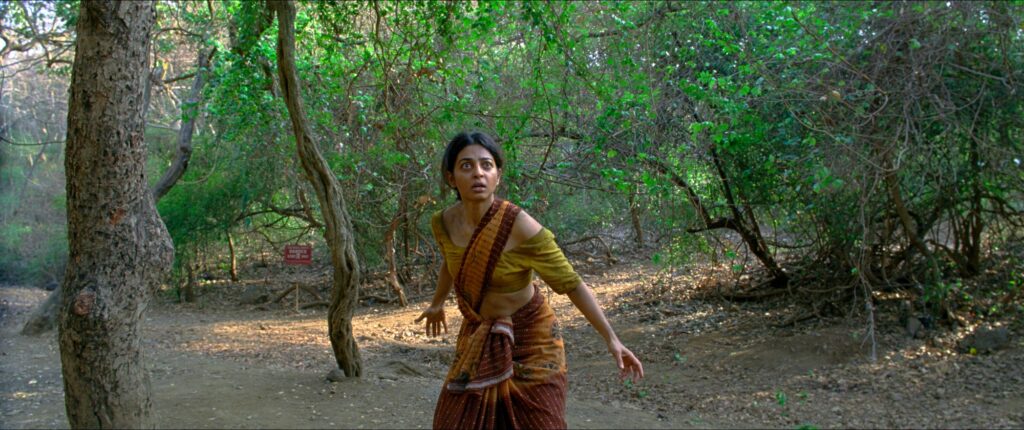‘Sister Midnight’ Displays the Talent of Its Screenwriter and Director, Karan Kandhari, but Does He Have Sufficient Discipline?
The odd thing about ‘Sister Midnight’ is how top-heavy it is, being a picture whose welcome is more wearying than its follow-through.

A nagging question plagued me as Karan Kandhari’s debut feature, “Sister Midnight,” came to an end: Why wasn’t the title song heard during its run? Mr. Kanhari would seem to be a fan of Iggy Pop: music from his ur-punk band, the Stooges, can be heard within the film and during the closing credits. Perhaps the estate of David Bowie, with whom Mr. Pop co-wrote “Sister Midnight” along with guitarist Carlos Alomar, didn’t clear its usage?
It’s a shame: The song’s elliptical lyrics and loping, trance-like cadence find their cinematic correlative in Mr. Kandhari’s movie and its disavowal of “society’s notion of ‘heroism.’” The rest of the soundtrack makes a point of its eclecticism and features tracks by the mid-20th century “King of Khmer Music,” Sinn Sisamouth, an American country singer, Marty Robbins, and one of the pinnacles of Chicago Blues, Howlin’ Wolf. The picture begins with the latter’s “Moanin’ at Midnight.”
“Music is the great love of my life,” Mr. Kandhari avers, “… in a sense this film is a sort of cultural collage. A weird tapestry of juxtaposition.” Juxtaposition, used abruptly and to jarring effect, is the modus operandi of “Sister Midnight.” The movie doesn’t unfurl so much as clatter. Working with his editor, the resplendently christened Napoleon Stratogiannakis, Mr. Kandhari sets up a series of tableaus that forgo ebbing-and-flowing for herking-and-jerking. Our screenwriter and director has been involved in music videos. It shows.
What also shows is the influence of that paragon of postmodernist affectation, Wes Anderson. The luxurious color palette, symmetrical compositions, fleet cutaways, and a nagging sense that narrative isn’t a function of metaphor so much as an avowal of directorial hubris — “Sister Midnight” is nothing if not Andersonian. It’s a young man’s venture, this picture, and its chief earmark is fearlessness. The impudence by which Mr. Kandhari upends convention is one of the best things about it.

This impudence is also a liability, particularly given how “Sister Midnight” meanders, often winding up in alleys that are no less blind for being compelling or weird. The story begins simply: Uma (Radhika Apte) and Gopal (Ashok Pathak) are a newly married couple from the sticks who settle in the big city, in this case, Mumbai. Uma is foul-mouthed and tempestuous; Gopal, soft-spoken and nonplussed. They live in a one-room shack on a congested thoroughfare. Their prospects are slim.
Neither husband nor wife are prepared for marriage. Gopal spends long hours at a job for which he is poorly paid and comes home drunk each night. Uma contends with boredom and learns about men and cooking from a next-door neighbor, the gruff Sheetal (Chhaya Kadam from “All We Imagine As Light“). Uma begins working as a cleaning woman on the graveyard shift. Right about the same time, she becomes host to strange obsessions and alarming behaviors, the hows-and-whys of which are left frustratingly vague.
What follows is a bait-and-switch genre-bender that is remarkably blithe in spirit notwithstanding a series of Grand Guignol sidebars. After beginning as a bombastic takedown of patriarchal structures, the film turns into a fairy tale whose tangents are often poetic to a fault.
Ms. Apte brings an impressive physicality to her role as a woman given to extremities of fortune, and Sverre Sørdal’s cinematography finds an unlikely balance between gothic ambiance and cartoonish stylization. The odd thing about “Sister Midnight” is how top-heavy it is, being a picture whose welcome is more wearying than its follow-through. Mr. Kandhari has talent. Whether he has the discipline to give it shape remains to be seen.

